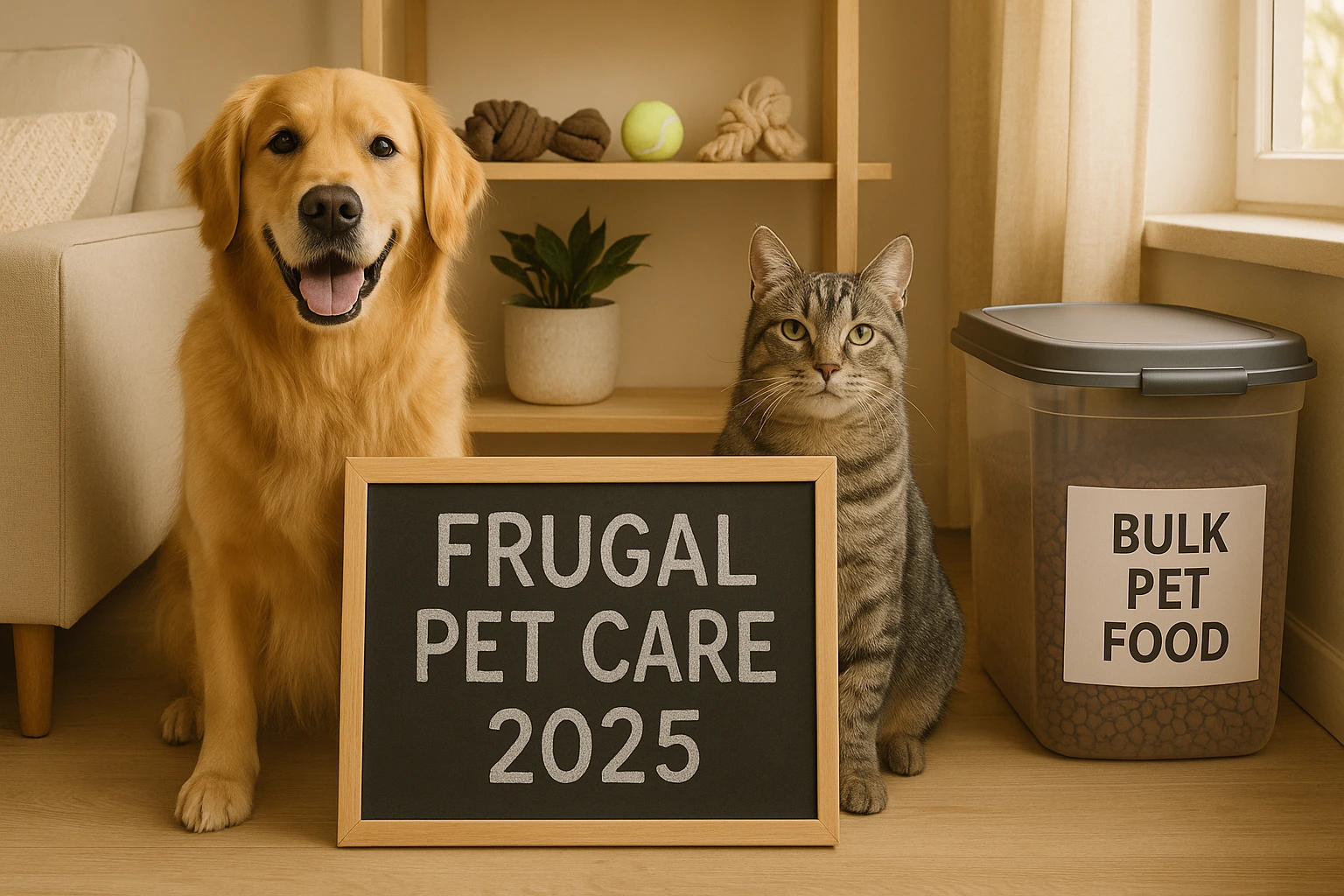
Love your pet, hate the bills? Annual pet costs often land around $1,100–$1,400, depending on size and care choices—yet you don’t have to overspend. This guide to frugal pet care shares vet-aware, wallet-friendly ways to lower food, grooming, and vet costs without cutting care. For a deeper dive into saving across your whole life, see our comprehensive guide to frugal living.
Unlock Your Pet Care Savings Instantly!Table of Contents
- Key Takeaways for Budget-Friendly Pet Care
- Cost-Effective Pet Food Strategies
- Budget-Friendly Vet Care
- Try Our Pet Care Budget Optimizer
- Thrifty Grooming Tips
- Affordable Pet Supplies
- More Money-Saving Tips
- Frequently Asked Questions
- Conclusion: Smart, Budget-Friendly Pet Care Tips
Key Takeaways for Budget-Friendly Pet Care
- Shop Smart: Snag deals by buying food and treats in bulk from places like Chewy to cut monthly costs.
- Get Crafty: Whip up toys and grooming hacks from stuff at home to save big on pet care. ✂️
- Stay Ahead: Regular vet checkups and shots keep emergencies and big bills at bay. 🩺
- Think Outside the Box: Stash cash in a pet savings account or tap discount programs for unexpected vet costs.
Cost-Effective Pet Food Strategies for Frugal Pet Care
Bulk Buying: Bigger Bags, Lower Price Per Pound
Pet food can gobble up your budget, but smart shopping saves big on pet food costs. Buying larger bags usually lowers the per-pound price. Scoping out prices at Chewy, Amazon, or Petco can score you awesome deals. Autoship and subscription programs from major retailers often include discounts and free-shipping thresholds. Check current terms when you order. Match bag size to your pet’s intake so food stays fresh. Oh, and keep an eye out for summer sales or compare wet versus dry food prices to find what’s cheapest for your buddy. For more budget-friendly shopping tips, check out our guide on Grocery Shop Save Money: 15 Smart Strategies That Work.
- Autoship Programs: Often include discounts and free shipping.
- Compare retailers: Check Chewy, Amazon, or Petco for deals.
Store-Brand/Budget vs. Premium Brands
Premium brands like Royal Canin or Purina Pro Plan pack top-notch ingredients, but store brands (e.g., Kirkland Signature or 4Health) can work well for many healthy pets. Look for the AAFCO nutritional adequacy statement (“complete and balanced”) that matches your pet’s life stage, and ask your vet before switching. Dogs can often handle general blends, but cats need more protein, so read labels closely. Switching to budget brands can cut your food bill while keeping your pet in great shape.
| Feature | Premium (e.g., Royal Canin / Purina Pro Plan) | Store-Brand/Budget (e.g., Kirkland Signature / 4Health) |
|---|---|---|
| Price Range | Higher | Lower |
| Formulas | Many targeted options | Fewer specialized choices |
| Nutrition | AAFCO-complete; brand R&D focus | AAFCO-complete; cost-efficient ingredients |
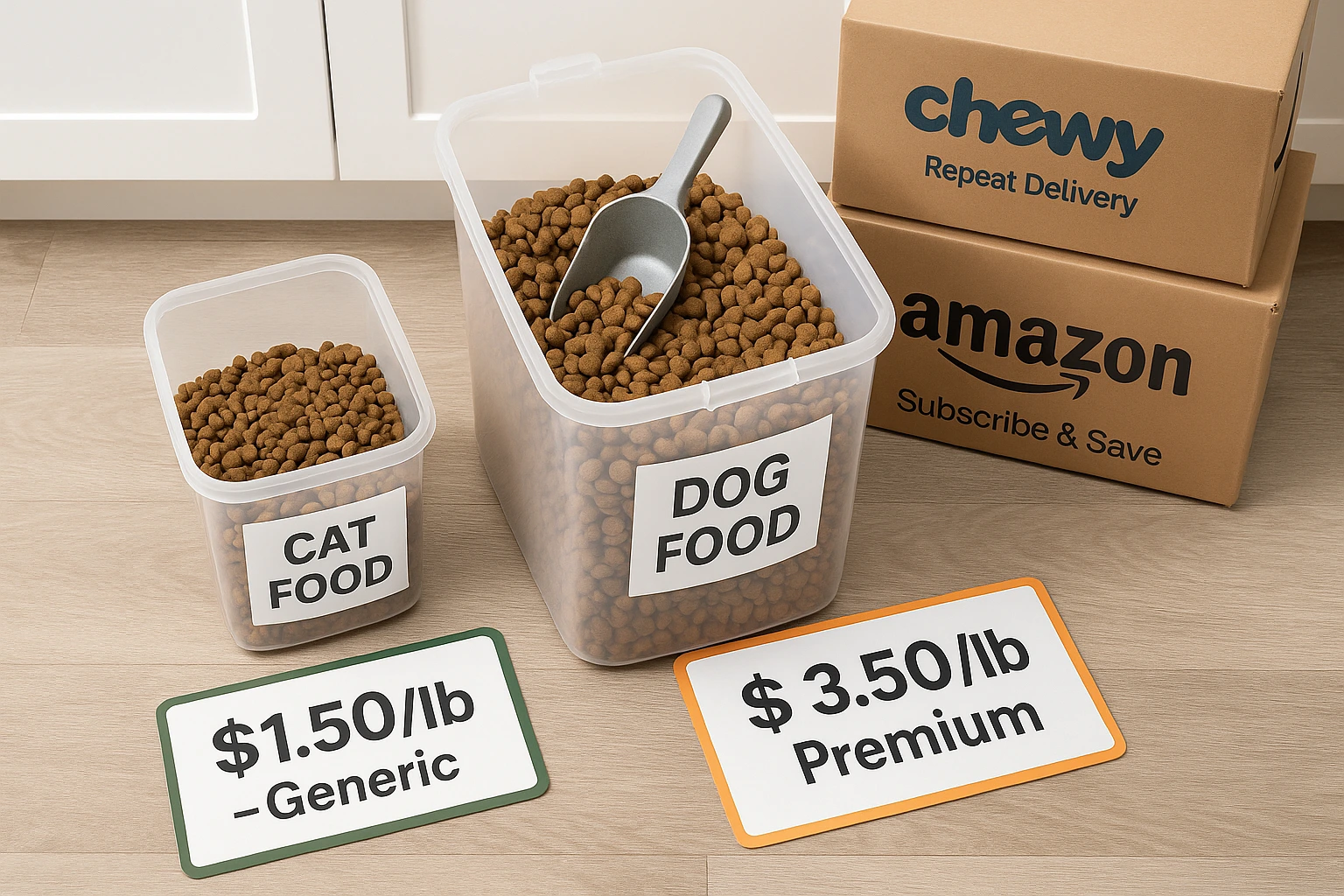
Label check: Pick food labeled for your pet’s species and life stage, and look for the AAFCO adequacy statement (that’s what “complete & balanced” refers to).
Budget-Friendly Homemade Treats
Homemade treats can cut costs and let you control ingredients—perfect for budget-friendly pet care. Many dogs love simple peanut butter bakes, while most cats prefer fish-based flavors. Try the easy ideas below, or browse more wallet-friendly meal inspiration in our Frugal Meal Planning: Eat Well for $50/Week guide:
- Peanut Butter Banana Bites: Mash banana, mix with peanut butter and flour, then bake at 350°F for 15 to 20 minutes.
- Sweet Potato Chews: Thinly slice sweet potatoes and bake at 250°F for 3 to 4 hours.
- Frozen Yogurt Pupsicles: Blend yogurt with fruit and freeze in ice cube trays.
Safety note: Use peanut butter without xylitol; never feed grapes/raisins, chocolate, onions/garlic; most cats are lactose intolerant—skip dairy or use pet-safe alternatives.
Preventing Food Waste
Store dry food in a cool, dry place (ideally under 80°F) and keep it in its original bag—or place the entire bag into your storage bin. Refrigerate opened wet food promptly and use it within a few days. See the FDA’s pet food storage tips for details.
Budget-Friendly Vet Care
This post contains affiliate links. If you buy through our links, we may earn a commission at no extra cost to you. Learn more.
Get Vet Guidance in Minutes
Unsure about switching foods or which tests can wait? Chat with a licensed vet for practical, budget-friendly next steps.
Preventative Care Saves Money
Preventive care saves money. Regular checkups catch problems early, so you avoid bigger bills later. Plus, telehealth vet services can help with minor questions and follow-ups, sparing you a clinic visit when appropriate. Veterinary schools and nonprofit clinics may offer lower-cost options for routine care. Make sure any provider is legit and licensed.
- Annual checkups: Spot issues early.
- Vaccinations: Shield against serious diseases.
- Dental care: Helps prevent periodontal disease.
Low-Cost Clinics and Shelters
Many areas have low-cost clinics or shelter programs for vaccines and spay/neuter. Shelters also run free or discounted microchip events. Check your shelter’s website, social pages, and local community boards for dates and prices. You can also browse our Best Freebies for Frugal Living (2025 List) to spot similar money-savers.
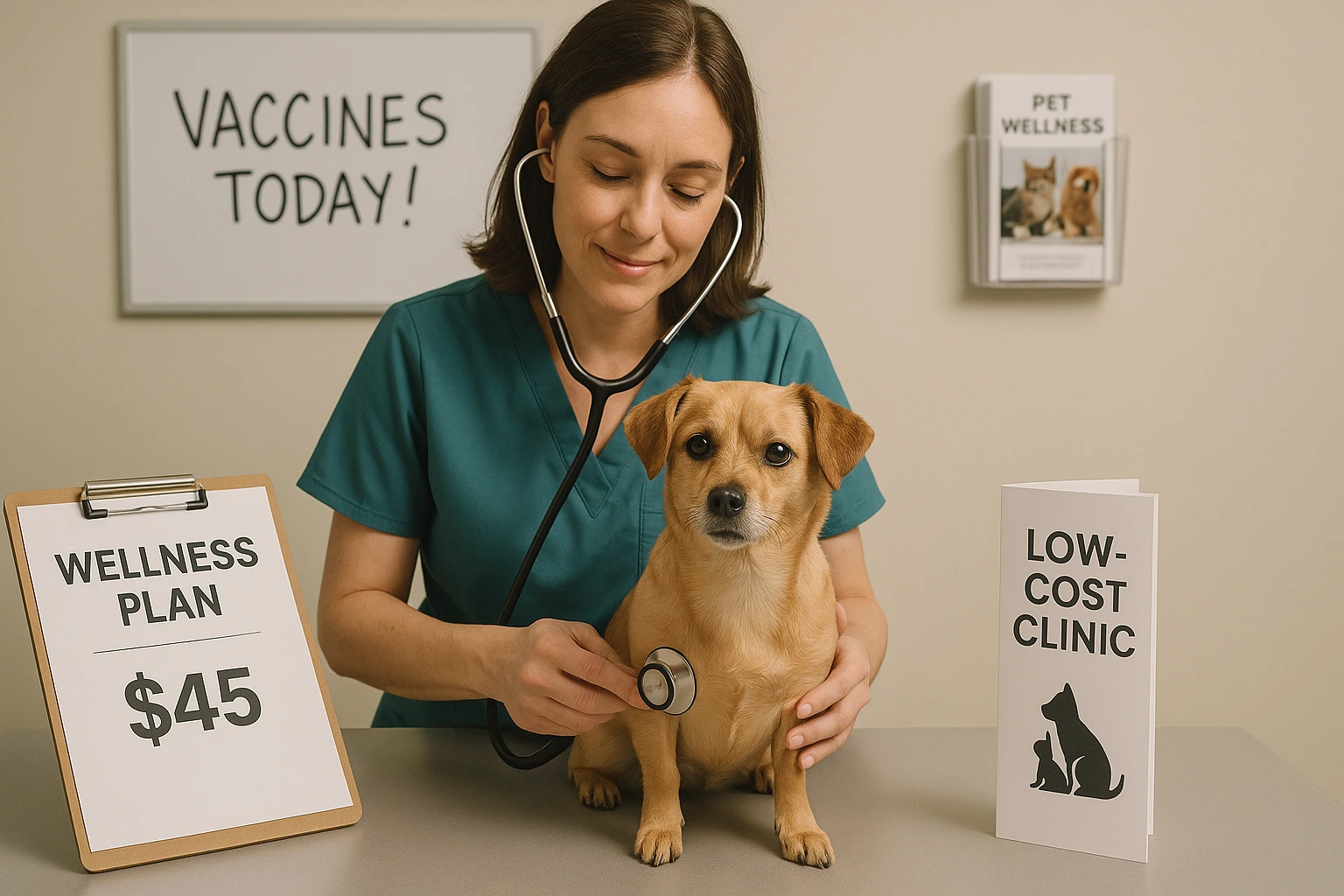
Pet Insurance Alternatives
Pet insurance adds a monthly bill, but it can blunt the cost of big emergencies. Depending on your budget and risk tolerance, a pet savings fund, a clinic wellness plan, or financing (e.g., CareCredit) can help. Some clinics bundle routine care into discounted plans—ask what’s included and compare the math.
Money talk: If costs are a concern, ask your clinic about payment plans or financing. Use telehealth for simple questions only; emergencies need in-person care.
Negotiating Vet Bills
If cost is a concern, say so. Many clinics offer cash discounts or payment plans. Ask whether a generic medication is available and whether any tests or treatments can be staged.
For bigger visits, request a line-item estimate and ask which items are essential now versus safe to delay. Request generic medications when appropriate and see if diagnostics can be staged without risking your pet’s health.
Try Our Pet Care Budget Optimizer
Use this tool to spot quick wins for frugal pet care. Pick the options that match your routine and we’ll estimate potential savings.
Thrifty Grooming Tips
DIY Grooming Essentials
Salon visits add up fast. You can trim costs with simple at-home grooming. Use slicker brushes for long coats and bristle brushes for short coats. Cats do best with wide-tooth or dematting combs; many dogs benefit from a de-shedding tool. Invest in sturdy nail clippers and a pet-safe shampoo. Long-haired breeds (e.g., Persians) need near-daily brushing; short-haired breeds (e.g., Beagles) are usually fine weekly. For more DIY ideas, see our Frugal Cleaning Hacks: Save $100s on Supplies.
- Brushes: Pick the right one for your pet’s coat.
- Nail Clippers: Invest in a solid pair for safe trims.
- Shampoo: Stick to pet-specific to avoid irritation.
- Towels: Stock up for drying.
At-Home Grooming Techniques
Brush regularly to stop mats, and bathe now and then to keep things fresh. For cats, gentle brushing cuts down on hairballs; for dogs, check for ticks while grooming. Trim nails to prevent overgrowth and clean ears to avoid infections. Go easy to keep your pet comfy.
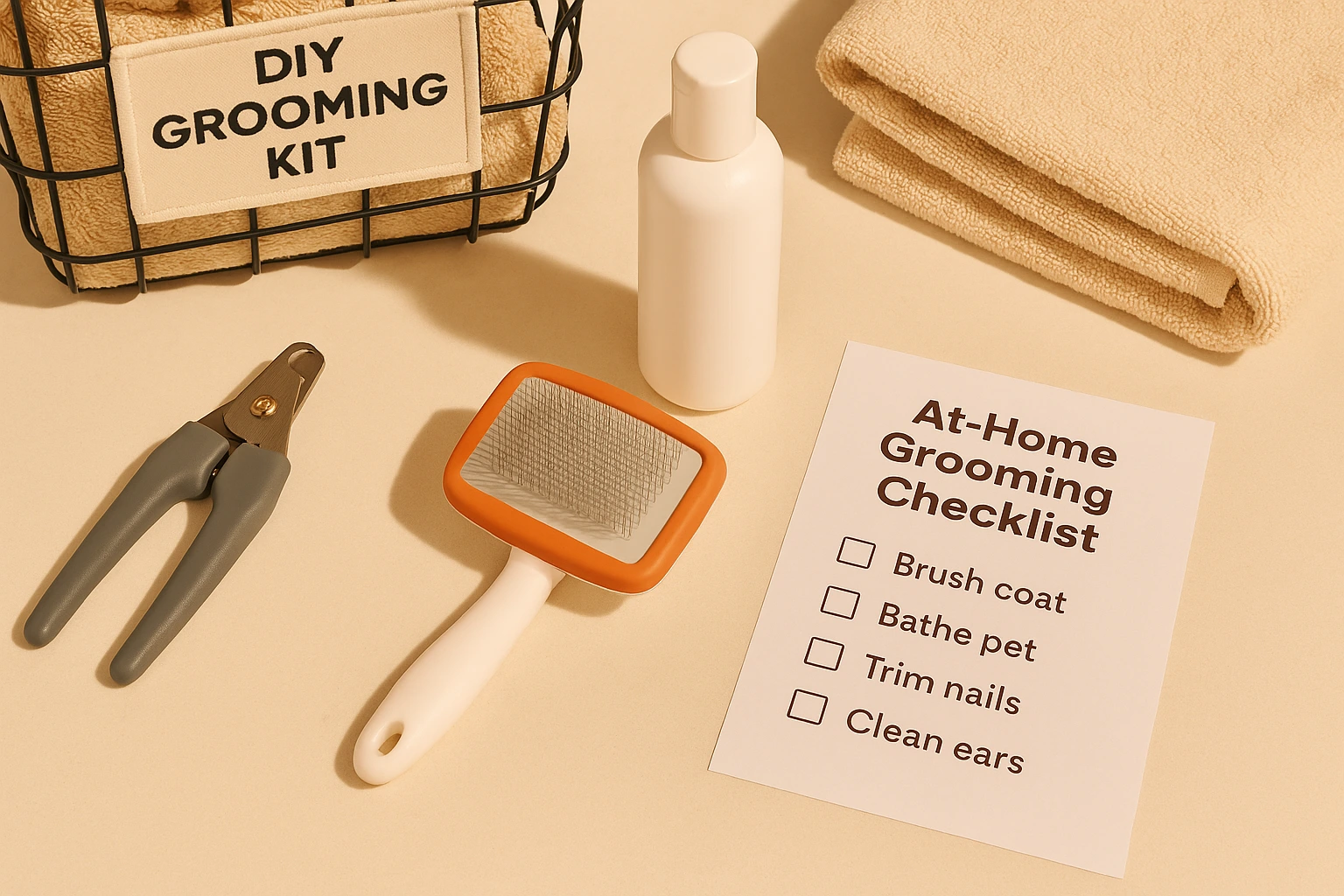
DIY Dog Shampoo
Use a pet-specific shampoo as directed. In a pinch for dogs only, some owners dilute unscented baby shampoo (about 1:10 with water)—avoid eyes/ears, rinse well, and stop if any irritation appears. Don’t use dish soap or vinegar mixes on cats. When in doubt, ask your vet what’s safe for your pet.
Worried About Skin or Shampoo?
Ask a vet about safe grooming for your pet’s coat and sensitivities—before you try a new product or routine.
Affordable Pet Supplies: Cheap Pet Supplies That Last
DIY Pet Toys
Toys add up fast, but budget-friendly pet care covers playtime too. Using cheap pet supplies like these keeps costs low while your pet stays engaged. Turn everyday stuff into toys—old socks become tug ropes, and a crumpled paper ball can be a cat’s best friend. For more ways to repurpose household items, see our Frugal Home Furnishing Guide.
- Towel Knots: Knot old towels for a tough chew toy.
- Cardboard Puzzles: Hide treats in a box with holes.
- Tennis Ball Treat Hiders: Slit a tennis ball and stuff with treats.
- Plastic Bottle Crunchies: Tuck a clean bottle in a sock and tie it off.
Safety note: Use these as supervised play only. Strong chewers can tear tennis balls or bottles—replace with tougher puzzle feeders or snuffle mats if your pet destroys toys.
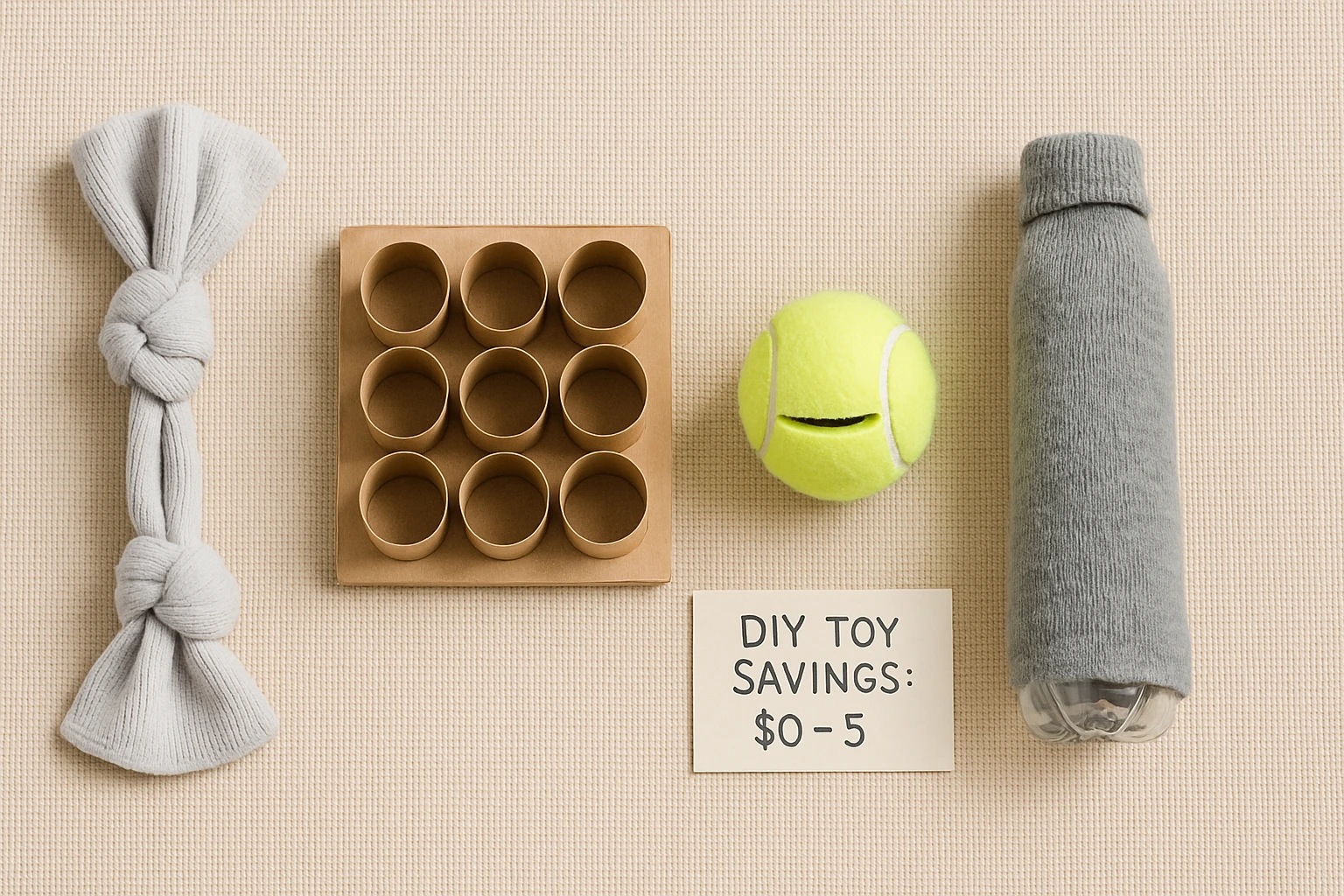
Where to Find Cheap Pet Supplies (Beds & Bowls)
Check thrift stores or Facebook Marketplace for gently used beds and bowls. You’ll often spot great-condition gear for a fraction of the price. Or repurpose old blankets or pillows into a cozy bed. Watch for Black Friday or post-holiday sales to snag bigger items for less.
Choosing Durable Leashes and Collars
Skip the flashy stuff and go for solid nylon or leather. Check for double-stitching and sturdy metal hardware—give the clip a few tugs before you commit. Brands like PetSafe often pop up on sale at big-box stores. Pick an adjustable collar that fits two fingers snug, and do a quick price check online before you pay.
More Money-Saving Tips
Quick win: Sarah saved about $200 in three months by switching to a vet-approved budget food and making a few DIY toys. Catching sales on leashes and harnesses helped, too. Want similar results? Try these:
- Shop around: Compare prices at local stores and online before you buy.
- Loyalty Programs: Join Petco’s rewards for perks like 10% off or free goodies after a few purchases.
- Social Media: Keep an eye on pet brands’ Instagram for flash sales and promos.
- Adopt Older Pets: Shelter adults can cost as little as $50, compared to $500 or more for puppies or kittens.
- Barter Services: Trade pet-sitting or dog-walking with other pet parents for supplies or help.
- Avoid Impulse Buys: Stick to a budget and only grab what your pet really needs.
Frequently Asked Questions
Not Sure What’s Necessary?
Get clear guidance on what to do now versus what can wait—so you protect both your pet and your budget.
Conclusion: Smart, Budget-Friendly Pet Care Tips
Smart, budget-friendly pet care isn’t about cutting corners—it’s about habits that keep your pet happy and your budget steady. Reuse what you can (DIY toys, second-hand beds), buy staples in bulk, and stay on top of routine vet care. When in doubt, ask your vet what’s truly necessary. Here’s to saving more and spoiling them just the same.
For more ways to stretch your budget across all areas of life, dive into our Frugal Living Handbook: Save More in Every Area of Life for practical tips and strategies.